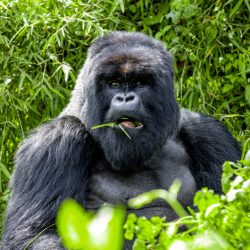Naming Gorillas in Rwanda
Blog | 24/06/09
Jamie – the IGCP Communications Officer – here again. I am recently back from Kwita Izina – Rwanda’s mountain gorilla naming ceremony.
Kwita Izina is held every year to name all the baby gorillas that were born in Volcanoes National Park in Rwanda in the past twelve months. This year eighteen babies were named, and a great diversity of officials and special guests were given the honor of picking the names.
The early 7 am start was misty and cool, with a several huge tents, a giant stage and a flock of volunteers ushering in guests and serving breakfast at the foot of the mighty Sabyinyo volcano near Volcanoes National Park headquarters. It was one of the world’s most spectacular settings for such a ceremony. The grounds filled up quickly, with a crowd of several thousand revelers. I took a seat outside with my IGCP colleagues and settled in for drumming, dancing, singing, theatre and several speeches before the main event of visiting dignitaries coming on stage and giving their chosen name to a gorilla.
httpv://www.youtube.com/watch?v=J31_zLUNSxM
Favorite performances were hard to pin down, as most of them were a totally new experience, which kept my camera, and my clumsy dancing feet, busy. I always am amazed by the energy of the traditional Intore dancers, though, with their long headdresses that look like a lion’s mane and their boundless energy. Another favorite was a singing quartet of American teenagers, who performed a note-perfect rendition of the Rwanda national anthem in Kinyarwanda! The quartet, in colorful traditional Rwandan dress, got one of the biggest applauses of the day.
httpv://www.youtube.com/watch?v=XyTXgfftXg8
As noon approached, it was finally time: the giving of names. The chosen givers represented a cross section of society from which inspiration springs, for gorilla conservation and human development, including senior Volcanoes National Park rangers, African musicians and governing body officials and special envoys, such as Ian Redmond, longtime mountain gorilla researcher and conservation professional who now serves as the UN ambassador for the 2009 Year of the Gorilla.
Each giver had an interesting personal story to tell about the name they chose, as “gorilla families” (people in gorilla costumes) roamed the grounds playing and grunting contentedly. The names often reflected the circumstances into which the babies were born, or characteristics of the babies themselves, as carefully observed by the Park rangers. Some reflected hope for the future of the species and the people of Rwanda.
Names included:
- Ijeneza (“future is bright”)
- Shyrambere (“go forward”)
- Umuganda (“work together”)
- and even Umutesi (“Spoiled Child”).
One young gorilla that immigrated from elsewhere into Rwanda – her origins are a mystery – was named Umurinzi, or Protector.
As the clouds parted and the hot sun finally lit up Sabyinyo volcano and the crowd, Rwanda’s Prime Minister, Bernard Makuza, closed the ceremonies with a speech highlighting recent achievements, with an eye and firm pledge to continued success in the coming year. All that remained was a closing song from the Rwanda All Stars (famous Rwanda pop musicians) and a hearty lunch for hundreds, as a local reggae band sent revelers down the mountain with a skip in their step.

A mother and her infant -- every birth is a victory for conservation. Paul Thomson took this photo while he was in Rwanda for AWF.
With all the bad news in recent times about loss of biodiversity, climate change and environmental degradation, Kwita Izina was, for me, a rare chance to celebrate a success. In the 1980s, researchers and organizations estimated mountain gorilla numbers to be between 300 and 400. Today there are approximately 700. Kwita Izina is a chance to celebrate that fact, and Rwanda and its conservation partners, in particular, have built a strong conservation record. One that is truly successful and continues to expand and evolve as the challenges of conserving the mountain gorilla and its natural heritage expand and evolve. Exhausted and elated, I slept well that night, looking forward to getting up and going to work for the gorillas on Monday, not full of dread, but of hope…..


